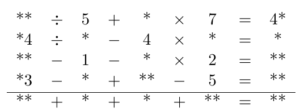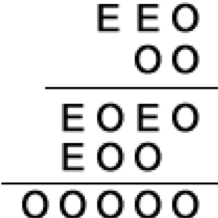Problems
In the rebus in the diagram below, the arithmetic operations are carried out from left to right (even though the brackets are not written).
For example, in the first row "\(** \div 5 + * \times 7 = 4*\)" is the same as "\(((** \div 5) +*) \times 7 = 4*\)". Each number in the last row is the sum of the numbers in the column above it. The result of each \(n\)-th row is equal to the sum of the first four numbers in the \(n\)-th column. All of the numbers in this rebus are non-zero and do not begin with a zero, however they could end with a zero. That is, 10 is allowed but not 01 or 0. Solve the rebus.

Decode this rebus: replace the asterisks with numbers such that the equalities in each row are true and such that each number in the bottom row is equal to the sum of the numbers in the column above it.
There are 6 locked suitcases and 6 keys for them. It is not known which keys are for which suitcase. What is the smallest number of attempts do you need in order to open all the suitcases? How many attempts would you need if there are 10 suitcases and keys instead of 6?
Three friends – Peter, Ryan and Sarah – are university students, each studying a different subject from one of the following: mathematics, physics or chemistry. If Peter is the mathematician then Sarah isn’t the physicist. If Ryan isn’t the physicist then Peter is the mathematician. If Sarah isn’t the mathematician then Ryan is the chemist. Can you determine which subject each of the friends is studying?
A square piece of paper is cut into 6 pieces, each of which is a convex polygon. 5 of the pieces are lost, leaving only one piece in the form of a regular octagon (see the drawing). Is it possible to reconstruct the original square using just this information?
At the cat show, 10 male cats and 19 female cats sit in a row where next to each female cat sits a fatter male cat. Prove that next to each male cat is a female cat, which is thinner than it.
The vendor has a cup weighing scales with unequal shoulders and weights. First he weighs the goods on one cup, then on the other, and takes the average weight. Does he deceive customers?
This problem is from Ancient Rome.
A rich senator died, leaving his wife pregnant. After the senator’s death it was found out that he left a property of 210 talents (an Ancient Roman currency) in his will as follows: “In the case of the birth of a son, give the boy two thirds of my property (i.e. 140 talents) and the other third (i.e. 70 talents) to the mother. In the case of the birth of a daughter, give the girl one third of my property (i.e. 70 talents) and the other two thirds (i.e. 140 talents) to the mother.”
The senator’s widow gave birth to twins: one boy and one girl. This possibility was not foreseen by the late senator. How can the property be divided between three inheritors so that it is as close as possible to the instructions of the will?
Decipher the following puzzle. All the numbers indicated by the letter E, are even (not necessarily equal); all the numbers indicated by the letter O are odd (also not necessarily equal).

Determine all integer solutions of the equation \(yk = x^2 + x\). Where \(k\) is an integer greater than \(1\).